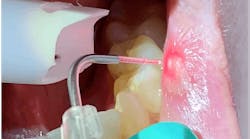By Ryan Hungate, DDS
Patient behavior has changed, especially among millennials and Gen Z: basically, in anyone under 40. They like going online to shop, order food, find information, and make reservations for everything from dining to traveling. And now, millions of people have become accustomed to online scheduling for COVID-19 tests, vaccines, and other health-care appointments. While some dental practices offer online scheduling, others are not yet ready to completely automate that process.
Adding a chat box to a dental website is an easy way to engage online users, impress them with your customer service, and convert their visits into appointments.
Defining live chat and chatbot
A chat box is a tool that is usually placed in the lower righthand corner of a website, and it enables visitors to type in questions and receive quick answers.
Live chat means those questions are answered by a real person. The live chat representative does not need to be a dental team member. Web chat services such as Simplifeye provide well-trained representatives who will engage visitors within seven seconds, 24 hours a day. They use an office profile to answer questions and gather the contact information, reason for the visit, insurance details, and other relevant information to forward to the practice to finalize the appointment.
A chatbot is a software application that uses preprogrammed responses to respond to website visitor questions. Typically, a practice employee must populate answers into the chatbot software. A chatbot then recognizes key words and phrases so that it can determine the best preprogrammed responses to provide each question. A majority of chatbots do not learn along the way, and the practice must constantly monitor and modify the bot to make it better.
Feel free to download a benefits comparison guide.
Comparing the results
The goal of live chat and chatbot services is the same: to convert website visitors into booked appointments. Both alleviate the frustration that many website visitors have if they call the office with questions and it’s closed or they’re put on hold or sent to voicemail.
Chatbots are popular with retail brands that can preprogram responses to frequently asked questions, such as information about return policies. Live chat services are popular within service-oriented industries where people require customized answers based on their specific needs. A DentistryIQ article published in 2019 found that adding a live chat feature to dental websites can double the number of website visitors who schedule from 3% to 6%.
Live chat versus chatbot considerations
Live chat and chatbot service providers vary greatly. Here are some things to consider before deciding which one to implement:
- Ease of implementation
Dental team members are busy. Choose a service that can be implemented quickly and easily, in minutes and not hours, and can handle the size of your practice or group. Ask for references or case studies.
- Availability
More than one third of website visits occur after a practice is closed. Ensure the chat service is available 24/7, including on weekends and holidays.
- Response speed
People are conditioned to expect an almost-instantaneous response. Select a chat service that will respond within seconds to chat requests.
- Appointment conversions
The goal of the chat box is to wow website visitors with your customer service and convert their visits into appointments. Select a chat provider that is HIPAA-compliant and can integrate with your practice management system or quickly and securely forward the appointment requests to the dental team to finish scheduling.
- Languages
If the patient base is diverse, it makes sense to hire a chat service that can converse in multiple languages. Chatbots are typically programmed to respond in just one language.
- Results tracking
Choose a chat service with an easy-to-use dashboard that lets you see results quickly. At a minimum it should include the number of chats broken down by time of day, how many chats resulted in appointment requests, and how many requests led to scheduled appointments. If it’s integrated with the practice management system, then the appointments can be tracked all the way through collections, providing a true return on investment measurement.
Consumer behavior is moving online
We live in a time when people expect to get information at the touch of a button. Eighty-eight percent of millennials say they prefer texting to calling, and 79% of all consumers say they prefer live chat because of the instant response, just a few of the interesting statistics from 99firms.
People of all generations say they like having the ability to chat online because it’s available 24/7, and they may not have time during normal business hours to make a call. As consumer behavior continues to move online, it becomes more important than ever to show your commitment to customer service and patient care. It can make the difference between a patient scheduling with your office or with your competitor.
Ryan Hungate, DDS, MS, is a practicing orthodontist and the founder and CEO of Simplifeye, a company that focuses on creating better workflows for dental practices to increase new patients, reduce overhead, and reduce bad debt. Dr. Hungate graduated from the orthodontic specialty program at the University of Southern California. Prior to dental school, Dr. Hungate worked for Apple Inc. and helped design the customer workflow adopted by Apple's retail stores globally. Dr. Hungate continues to practice orthodontics every month, volunteering to help children in need of orthognathic surgery, cleft palate treatment, and orthodontic care. For more information, visit Simplifeye.com.






